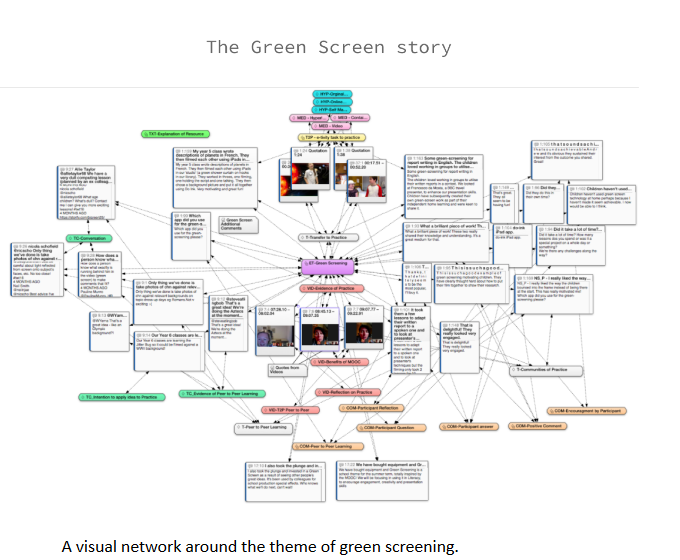Visualisation of networks within the TWT community
‘This (MOOC) is a complex hive for sure. The connection is very specific. A bee colony has a large community working together in a hive to achieve the same goal. Here, I've already seen many bee behaviours.
- Bees chipping in and helping with suggestions,
- a waggle dance to show others the way to good ideas and learning paths,
- passing resources from mouth to mouth until they become honey,
- encouragement for new bees and newbies,
- a cluster of bees together that generates warmth and security.’
Liz Jones, participant
Clear evidence of knowledge transfer, both from instructors to participants and peer-to-peer between participants.
Not as simple as implementing the e-tivities, but much more complex as people learn from each other.
Following an inductive examination of qualitative data to identify key themes, an analysis of online interactions across G+ Community and Twitter was undertaken using coding in Atlas.ti, with the aim of understanding the nature of the interactions and their impact on transfer to practice. There was clear evidence of knowledge transfer, both from instructors to participants and peer-to-peer between participants. Our participants were having virtual discussions about real practice. The knowledge transfer is not so much in what they have posted so much as the discussions around the posts. It is not as simple as implementing the eTivities, but much more complex as people learn from each other and knowledge transfer becomes closely linked to participants’ roles within the CoP.
Building on the ideas of social constructivist and connectivist learning, rhizomatic learning and seamless learning
Here the hybrid mooc moves on from Blackboard Open Education by bringing in the community. The linked codes show us a pattern of interactions around the theme of green screening. Using the visual network option we can build up a picture of a whole learning story on the theme of green screening. We looked at types of interactions within the comments. There are subcategories within the comments, such as questions, answers, encouragement and reflection. We can see how strongly the comments influence across the process.
Looking at the Twitter conversations, the instructors had a set of questions but what is interesting is the individuals having their own micro conversations within the context of the chat, triggered by a comment. This resulted in peer to peer learning through related but unintentional interactions. An example was from general conversation about green screening where one person was enthused by knowledge being shared and suggested she might now do green screening instead of a ‘boring’ computer lesson, and someone else stepped in and offered to share computing plans.
Many elements seen in the comments in the G+ posts added to these examples of peer to peer learning. For example there were questions, answers, reflections, encouragement by both participants and moderators. The community appeared to grow through these interactions. Where there were clear roles at the beginning (participants and moderators) these appeared to blur as the course continued. Moderators learned from Participants and vice versa. Participants took on the role as the expert, sharing, answering questions of other participants.
There is clear evidence in both the comments on G+ and the conversations in the Twitter Chat of peer to peer learning and transfer of knowledge to classroom practice. Participants are learning from each other and instructors are learning from the participants as well. As a result, the social aspect of this Hybrid MOOC has added to the depth of learning for those who have taken part. Our participants are having virtual discussions about real practice. The knowledge transfer is not so much in what they have posted so much as the discussions around the posts. It is not as simple as implementing the eTivities, but much more complex as people learn from each other and knowledge transfer becomes closely linked to participants’ roles within the CoP. The Atlas.ti visual networks allow us to describe this knowledge transfer process and gives us clear evidence of constructivist learning methodologies in practice demonstrating how the social elements of learning impact across the community. This links with CoP ideas which suppose knowledge acquired in the virtual world can be applied in the real world.
References:
Kimble, C., Hildreth, P. & Wright, P. (2001). Communities of Practice: Going Virtual. In Y. Malhotra (Ed.) Knowledge management and business innovation, Hershey, PA: Idea Group (220-234)
Wenger, E., White, N., Smith, J. D. & Rowe, K. (2005). Technology for communities. CEFRIO Book Chapter.


